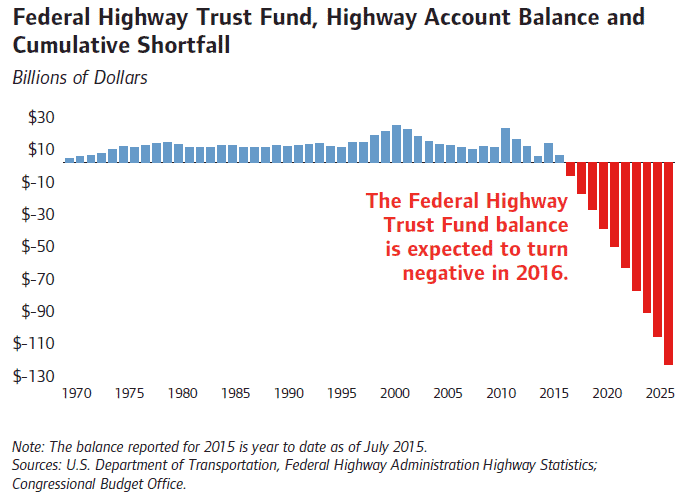Things are better in terms of rail infrastructure, perhaps driven by the fact that nearly all the assets are privately owned. In fact, in 2014 alone, spending on the freight rail system came in at a robust $28 billion. But even there, the report notes the dollars required going forward will also be massive, and that worrisome choke points in the rail system, such as in the Chicago area, seem to be growing.
Funding of Course Remains the Issue
So there are infrastructure issues and they are likely to get worse if the status quo is maintained. There is not much argument about that.
The report notes, for example, that US spending on the highway peaked in relative terms in the 1950s, at just under 2% of GDP. That metric has fallen slowly and steadily ever since, now down to just over 1%, a drop of about 40%.
Many see that as a clear sign that support for infrastructure has deteriorated, and by that measure it has. What the report does not mentioned is that over that same period, increases in other government expenditures such as social spending have exploded, crowding out infrastructure spending as a result.
Another major issue, the report says, is that where the billions of dollars that are spent on infrastructure is going is changing.
"Public spending on infrastructure operation and maintenance has been rising steadily since the 1960s, while spending on capacity expansions, major upgrades or new construction projects has grown at a much slower rate and has been in decline since the 2000s," the report says. That is in part, of course, because the costs of such maintenance type projects continue to rise.
Regardless of how it happened, the report says the estimated gap between capital investment needs for infrastructure and projected funding is $481 billion for surface transportation by 2020 and $258 billion for the aviation sector and ports and inland waterways by 2020.
The report notes the lack of a true so-called Highway bill since 2009, which has been kept alive after it expired through an on-going series of continuing resolutions to keep the dollars flowing at those existing levels.
While there are signs a new federal Highway bill may indeed soon be passed, it appears it will largely maintain the status quo. The report includes the graphic below, which shows based on those current funding levels that the Highway Trust Fund will go negative in 2016, with the deficit rising substantially in the following years.

That means that either the deficit will either have to be closed out of general funds - which seems unlikely - or billions of dollars of funds even just maintaining the status quo will become unavailable.
So can that enormous gap even by realistically even be closed? That is the trillion question. SCDigest believes the chances of funding to fully meet what various studies say is needed will simply never be reached, even if there is some improvement in funding levels.
One obvious problem is what has happened relative to gas and diesel taxes. Last raised 22 years ago, the 18.4 cent per gallon tax on gasoline intended to finance the Trust Fund has lost 35% of its purchasing power since 1993 due to the combined effects of inflation, rising construction and materials costs, and increasingly stringent fuel efficiency standards. It's of course a similar story for the 24 cents per gallon federal tax on diesel (states of course add on additional taxes, which vary by state).
On the benefit side, the report cites a study by McKinsey that found that increasing US infrastructure investment by the equivalent of 1% of GDP per year could boost annual output across a range of industries by up to $320 billion. The problem of course is that this number is speculative and very hard to measure, while spending and fuel taxes are very real and easy to measure.
While such increases in infrastructure spending should also create hundreds of thousands of new jobs, in the end US business competitiveness should be the real driver, the report says.
"Highly performing, modern infrastructure systems lower the cost of doing business by reducing fuel expenditures, unproductive labor costs (e.g., wages paid to a driver to idle in traffic for several hours instead of making more deliveries), the time needed to transport inputs and final products from one place to another, and the costly effects of uncertainty," the report states.
In the end, unfortunately, the report does not offer a recommended path out of the current situation. Implied is the need to raise taxes on gas and diesel - a move which generally has strong support - but by how much? What should be the spending priorities? And at what point do the marginal costs for improving infrastructure start to exceed marginal benefits (however those benefits are measured)?
So the report makes a well-written and supported case for taking action, but offers little in the way for how to really address the issue. The main news in the end is that perhaps now corporate America will strongly push to change the status quo - something legislators are sure to notice.
The full report can be found here: The Case for
Investing in America’s
Transportation Infrastructure
How bad - or not - is US logistics infrastructure really? What should be the priorities? How much should we spend? Let us know your thoughts at the Feedback button (for email) or section (for web form) below.

|